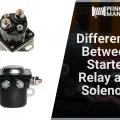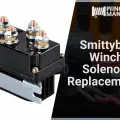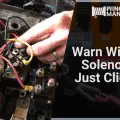At some point, many of us will experience some technical issues with our winches. Whether the cause is an electrical failure, mechanical failure, or simply old age, it is inevitable. But for the most part, when you experience some issues on your winch, it most likely is an electrical component.
The winch’s mechanical parts are very rugged and durable, so they broke rarely. On the other hand, electrical components are more subject to failure. They can get wet or exposed to corrosion. Any slight damage to electrical circuits can cause a winch to go haywire. Chief among the most vulnerable parts are the winch contactor or solenoid.
When you get in trouble with these electrical components, a replacement or a fix is needed. If you ever will need a replacement, which should you get for your winch exactly? A solenoid or a contactor? What’s the difference between the two in the first place? In this article, we are going to discuss all of these questions. Simply continue reading to know the answer!
At a Glance
Should I Even Consider These Questions?
What if you get any of the two components? Won’t it negatively affect my winch? Sadly, no. If you get a solenoid for your truck’s winch, then you are limiting your winch’s capabilities.
Installing a solenoid instead of a contactor would be like restricting 90% of the current, which is to say, a very inefficient method. You can’t afford to neglect to choose which of the two is best for your winch. To know which of the two is for your winch, we must know their differences and their roles.
Contactors or Solenoids?
Basically, contactors and solenoids are your winch’s on and off switch. Without it, you would need to hotwire a winch to turn it on, and even then, you can’t even control a winch properly. Your winch would just keep rotating its drum uncontrollably, and so this is not advised.
But before we get into an in-depth analysis of the two, let’s first explore the basics. We first need to study another switch called a relay, and only then can we understand contactors and solenoids.
What Is A Relay?
The relay is the most common electro-mechanical switch that is in use in vehicles. Its main job is to relay low electrical current—typically 40-100amps—to control a high-powered circuit. It can also allow controlling several high-powered circuits with only one electrical signal.
A modern car today uses relay switches to activate a vehicle’s headlights, fan motors, auxiliary lamps, and blower motors.
A relay switch can come in a host of different designs, from electromagnetic relays—which use a magnet to allow the flow of current—to solid-state designs, which allow electric current through the use of semiconductors.
Here are some different configurations of relay switches:
- Mini ISO Relays: It is a general-purpose switch that comes into the automotive industry as a blueprint. In short, it is the most basic you can get. It fits neatly to many vehicle electrical applications such as lighting, starting, horn, heating, and cooling.
- Micro Relays: It is a miniature plug-in design for use in the automotive industry, and it adheres to a universal standard pattern for electrical terminals. For any switching operations that need more than 35amps, a micro relay is handy.
- Maxi Relays: As its name suggests, it is a stronger version of the micro relays. A maxi relay works the same way as micro relays, except it is for heavy-duty applications. They are ideal for use in cooling fans, engine management, fuel control, and car alarms.
- ISO 280 Mini, Ultra, and Micro Relays: Its name looks like something that is highly exaggerated, but I assure you, it’s for a good reason. It is a smaller but compact version of the standard relays. But this time, it follows an ISO 280 footprint pin size and design. You can find these relays in ATM fuse boxes and power distribution units.
What Is A Solenoid?
Solenoids are just another type of relay switch. However, it is specifically engineered to remotely switch a heavier current—usually varying from 80-200amps. In contrast to smaller electro-mechanical relays, these relays use a coil to generate a magnetic field once a current passes through. Once this occurs, it opens or closes a circuit.
For the winch solenoids, it works the same way—by acting as a switch for your winch. Solenoids play the role of supplying the required current to the winch. Thus preventing any damage to the motor.
When you activate a winch, the current then flows to the solenoid from the battery, and thus your winch is now on. After activation, the current is shipped off the engine with the help of the solenoid to begin running the winch engine. A normal winch has two isolated solenoids for forward and reversing.
What Is A Contactor?
The contactor will be the main relay switch to use once a heavier current load is needed—usually varying from 100-600amps. With a voltage rating that can sustain 12V DC up to 12000V DC, contactors are the cheap and effective switch to use.
Normal applications include mechanical electric motors utilized in heavy-duty trucks and tools, transports, emergency vehicles, electric/hybrid cars, boats, light rail, mining, and different frameworks that essentially require an excessive amount of current for a standard relay or solenoid
Which One Should You Pick?
In terms of capabilities, the relays are at the low-end tier, followed by solenoids in the middle, and then contactors that sit at the top tier. Contactors can certainly handle the heaviest of jobs, however, sometimes, you don’t need that much power. Plus, contactors are far the heaviest and the most expensive of the three options. On the other hand, relays and solenoids are portable and inexpensive.
Pick which one do you need for the job. If you have a heavy-duty winch right now, then go for the contactor. On the other hand, if a solenoid is enough, then go for that option.
Also, pick whichever options will fit in the hood of your car. It’s useless to have a contactor if it doesn’t fit in the first place.
Conclusion
In the battle of which is better of the two options, there is no clear winner. At the end of the day, it depends on the user’s needs. Both of them have almost the same characteristics, except one is more heavy-duty than the other.
In short, if you need a switch that can hold raw power, contactor is the option. On the other hand, you need something just enough, solenoid is the way to go.
If you want to learn more about winching needs, check out these articles:



